The Economics and Statistics Division maintains archives of previous publications for accountability purposes, but makes no updates to keep these documents current with the latest data revisions from Statistics Canada. As a result, information in older documents may not be accurate. Please exercise caution when referring to older documents. For the latest information and historical data, please contact the individual listed to the right.
<--- Return to Archive
For additional information relating to this article, please contact:
September 29, 2020NOVA SCOTIA QUARTERLY POPULATION ESTIMATES AS OF JULY 1, 2020 The production of the demographic estimates are based on methods and models that allow reliable and accurate population estimates; however, in the context of the COVID-19 pandemic, the assumptions of the models maybe invalid and administrative data sources are not optimal in terms of timeliness and completeness. Statistics Canada has released a technical supplement on how production methods were modified for Q2 estimates. Adjustment for deaths were made to use data on provisional death counts and COVID-19 deaths rather than standard methodology estimates. Emigrant, returning emigrants and net temporary emigrants estimates were adjusted lower on examination of auxiliary data sources. The usual methods for births, immigration and interprovincial migration were not modified for Q2 estimates with the data sources picking up the COVID-19 impacts. Further methodological changes are under consideration for future estimates

Nova Scotia’s population increased by 2,308 between April 1, 2020 and July 1, 2020. The population as of July 1, 2020 was 979,351, the highest population for Nova Scotia on record. Since April 1, 2015 Nova Scotia's population has increased by 43,080. This quarter's increase reflects an increase in immigrants, net interprovincial migration and net non-permanent residents and a decrease in natural population change.
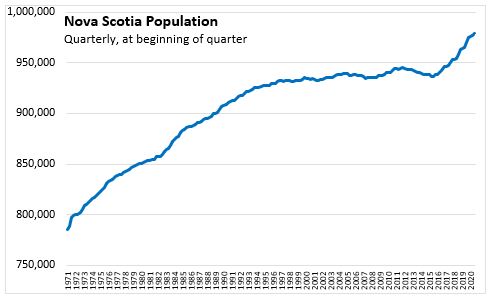
There are seasonal patterns in quarterly population changes, particularly evident in births and migration. The population growth in Q2 2020 was slower than any of the previous four years as immigration and non-permanent resident population growth slowed.
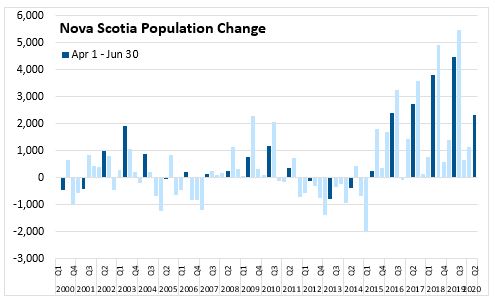
In the latest quarter, Nova Scotia’s population increased by 0.24 per cent compared to the April 1 estimate, above the pace of the national population which grew 0.07 per cent. Compared with July 1, 2019 Nova Scotia’s population has increased by 0.99 per cent, or 9,604, while the national population grew by 1.10 per cent.
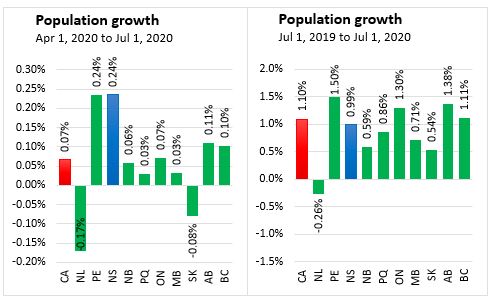
Immigration from other countries has been a strong contributor to population growth in Nova Scotia in recent years. In Q2, 2020 immigration slowed across Canada, particularly in April but started to move back up in May and June. The COVID-19 pandemic, travel restrictions, and Immigration, Refugee, Citizenship Canada (IRCC) operational challenges likely had an effect on immigration numbers in Q2 2020. Nova Scotia received 866 immigrants during the second quarter of 2020.

In this quarter, Nova Scotia saw a net gain of 214 non-permanent residents since April 1, 2020, below Q2 numbers that occurred in recent years.
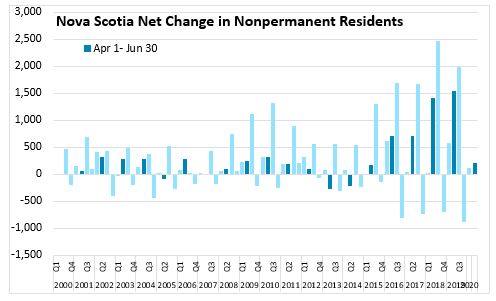
Nova Scotia’s natural population change (the number of births, less the number of deaths) has been negative for several years. Between April 1, 2020 and June 30, 2020, there were 2,078 births and 2,296 deaths, amounting to a natural population decline of 218.
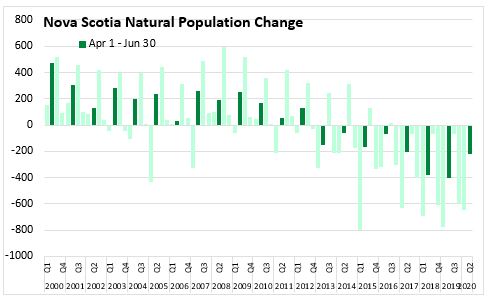
Net interprovincial migration to Nova Scotia had a smaller increase in Q2 2020 relative to recent years with a gain of 1,443 to the population. Migrants from other parts of Canada were 5,602 compared to 4,159 persons leaving for other provinces. Interprovincial migrant flows across Canada were down compared to last year amid COVD-19.
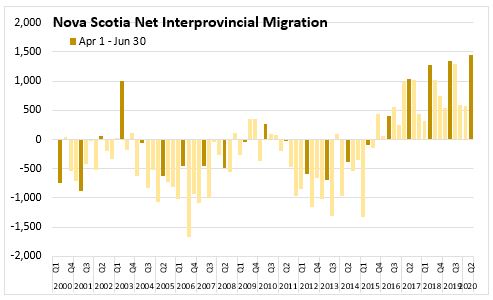
Out-migration from Nova Scotia to other provinces decreased by 579 persons compared o the second quarter of 2019. Out-migration declines were mostly from fewer movers to Ontario, Alberta, Manitoba, and Saskatchewan
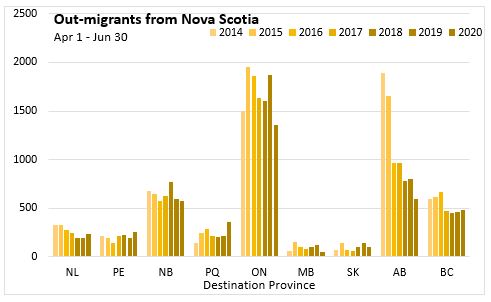
Compared to Q2 2019, in-migrants to Nova Scotia decreased by 534. The largest in-migrant declines were from fewer people moving from Ontario, Quebec, and the other Atlantic provinces. In-migrants increased from Alberta (+104) compared to Q2 2019.

Interprovincial migration to Nova Scotia was a net inflow of 1,443 persons in Q2 2020. There were net inflows from seven provinces with largest coming from Ontario (+641), Alberta (+392) and British Columbia (+210). The largest net outflow was to Quebec (-129) and Prince Edward Island (-84).
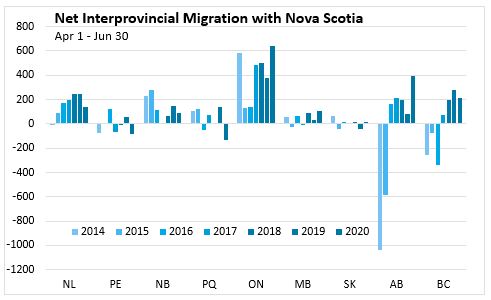
Source: Statistics Canada.
Table 17-10-0009-01 Population estimates, quarterly
Table 17-10-0020-01 Estimates of the components of interprovincial migration, quarterly
Table 17-10-0040-01 Estimates of the components of international migration, quarterly
Table 17-10-0045-01 Estimates of interprovincial migrants by province or territory of origin and destination, quarterly
Table 17-10-0059-01 Estimates of the components of natural increase, quarterly
<--- Return to Archive